
Structural databases as teaching tools session chairs and presenters. From left to right: (back row) Joel Sussman, Christine Zardecki, Alexey Kikhney, Sameer Velankar, Jaime Prilusky, (front row), Urmila Kulkarni-Kale, Shuchismita Dutta, and Hirofumi Suzuki.
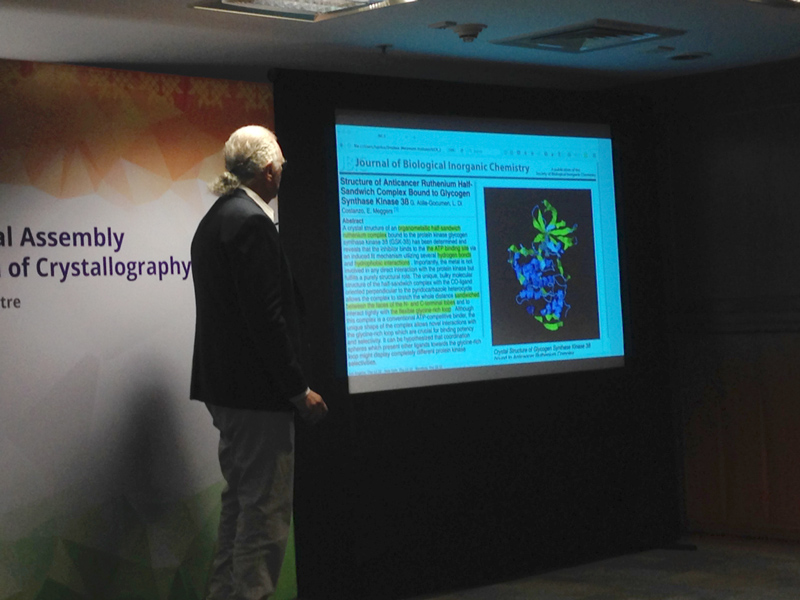
Prilusky presenting Enlightening macromolecular structure-function relationship
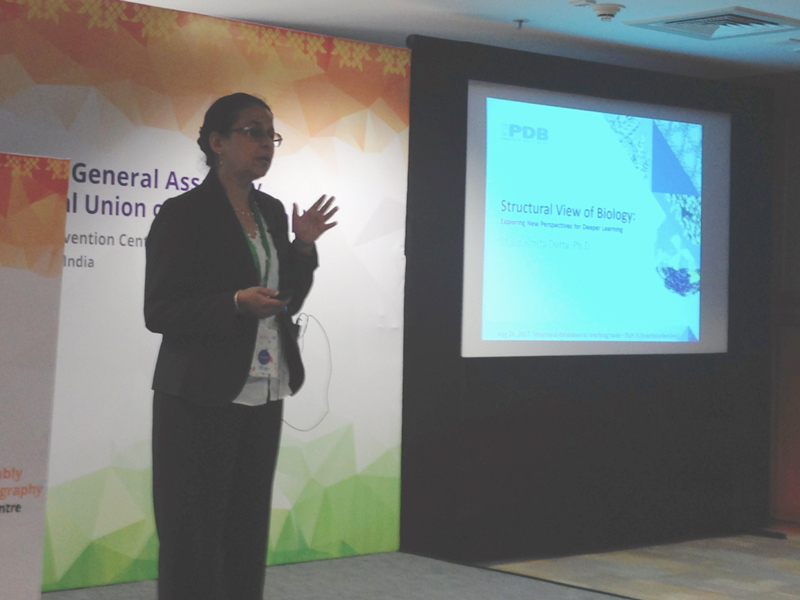
Dutta presenting Structural view of biology: Exploring new perspectives for deeper learning
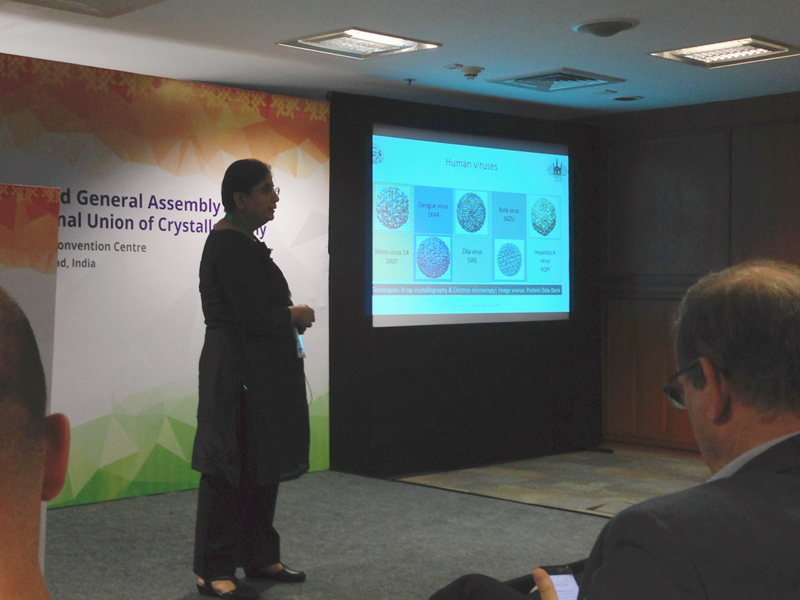
Kulkarni-Kale presenting Disease to therapeutics via 3D structures: stories from viral world
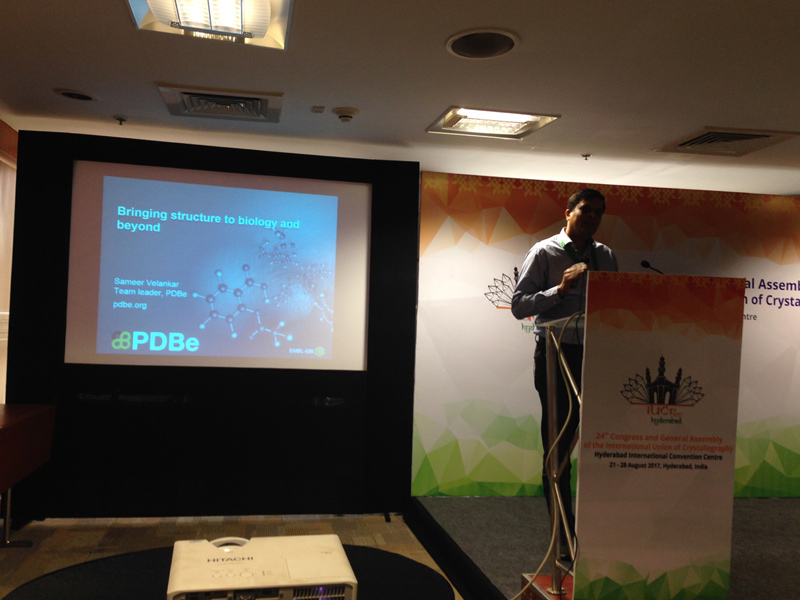
Velankar presenting PDBe: Bringing structure to biology and beyond
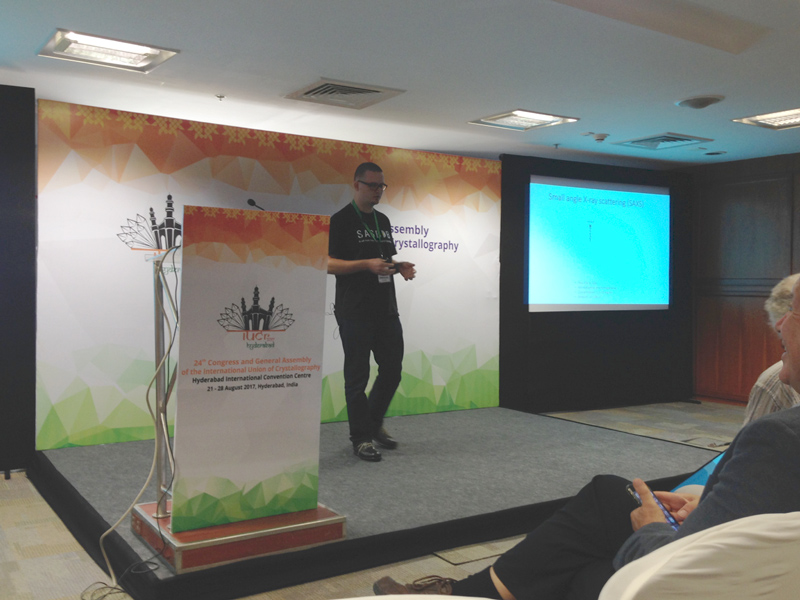
Kikhney presenting SASBDB and DARA as biological solution scattering teaching tools

Suzuki presenting Play with 3D structure data of biomolecules
Free, public access to the structural data made available in the PDB archive strongly benefits scientific research. These data determined using X-ray crystallography, NMR, and 3D electron microscopy can be used and re-used in other studies and experiments that further our understanding of biology and medicine.
Every three years, the International Union of Crystallography (IUCr) brings together thousands of researchers interested in all aspects of crystallography, from minerals to large biological macromolecular machines. In the microsymposium Structural databases as teaching tools (macromolecules), six researchers described the ways in which the availability of structural data and related bioinformatics resources is a powerful tool for teaching and education.
The session was chaired by Joel Sussman (Weizmann Institute) and Christine Zardecki (RCSB PDB).
This Wiki-like setting is a powerful tool for researchers and educators alike. Anyone can contribute; all authors receive credit at the bottom of pages they create. There are >3500 contributers, worldwide, to Proteopedia adding pages, and it is also serves as complementary pages for > 13 journals. It is a tool used in courses throughout the world, including Australia, Brazil, Finland, France, and the USA.
Access: proteopedia.org
Resources for high school teachers: highschool.molviz.org
RCSB PDB hosts two websites for exploration of the PDB archive: the main RCSB PDB site was developed with researchers in mind, with PDB-101 intended for teachers and students. Sections of PDB-101 focus use on global health issues as a mechanism to promote student interest. Curricula developed in collaboration with teachers and subject-area experts are available to explore diabetes, with additional themes to come.
Access: RCSB.org and PDB101.rcsb.org
Resources for introduction to Structural Biology: Molecule of the Month
Urmila Kulkarni-Kale (University of Pune) described several examples of how 3D structures are game changers in basic research, drug design, and vaccine design in relation to viruses.
When developing bioinformatics tools, it is important to consider how different users have different needs and utilize different meanings. The ideas of structural “similarity” and “differences” will vary between, for example, biochemists and immunologists.
In bioinformatics studies, her Masters students develop databases that demonstrate how public domain data can be gainfully utilized for the development of anti-viral strategies. In one example, PDB virus structures were used for analysis and compiled into specialized predication databases, leading to an in silico pipeline for vaccine development. Examples were shown of how small differences in viral sequences can have profound effect on the efficacy of vaccines.
Access:
AgAbDB: a derived knowledgeable of Ag-Ab interactions
AllerBase: an Allergen Knowledgebase
At Protein Data Bank in Europe, Sameer Velankar and his team have used a variety of strategies to reach potential researchers (students 14-18 years old) to expert scientists interested in better using PDB data.
In schools in Cambridge, UK, PDBe has worked with both the Art and Science Departments to use the beauty inherent in 3D biological macromolecules to spark the interest of students. The results are posted on the PDBart Pinterest page.
To better serve PDB users interested in understanding the biological story of why a molecule is functioning or not functioning, PDBe pulls information from other external databases that can help. In particular, the SIFTS project offers current for residue-level mapping between UniProt and PDB entries and annotations from other resources.
Another important tool is visualization. Representation and coloring are tools which can quickly answer some basic questions about a structure (unique macromoleucles, overall shape, location of given sequence or domain). In addition, PDBe offers topology maps that depict secondary structure and the interactions of these secondary structure elements. Value-added annotations from SIFTS are also included.
Access: PDBe pinterest, pdbe.org, SIFTS
Alexey Kikhney (EMBL-Hamburg) demonstrated how the SASBDB and DARA resources are extremely useful biological solution scattering teaching tools as well as for getting an initial idea of the overall structure of an unknown protein or protein complex.
The databases can be searched or browsed. Entries are connected to the corresponding scientific literature to provide additional context.
Alexey demonstrated the process of comparing SAXS entry plot data and PDB data to visualize the fit of the two models.
In the final presentation, Hirofumi Suzuki (Protein Data Bank Japan) wore Red-Cyan glasses while demonstrating how playing with 3D biomolecular structures is easy and fun using PC, mobile, and VR software tools hosted by Protein Data Bank in Japan. These 3D visualizations have proved to be very popular with students and at Science Festivals.
The PDBj website also offers additional tools, including the eProtS Wiki-style encyclopedia and a Japanese translation of the RCSB PDB’s Molecule of the Month series. This translation is one of the most popular educational features on the website.
Access: PDBj, pdbj.org/prime